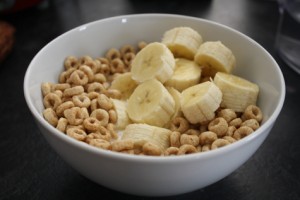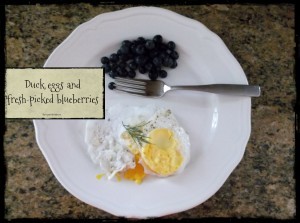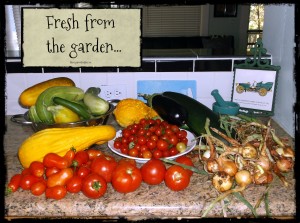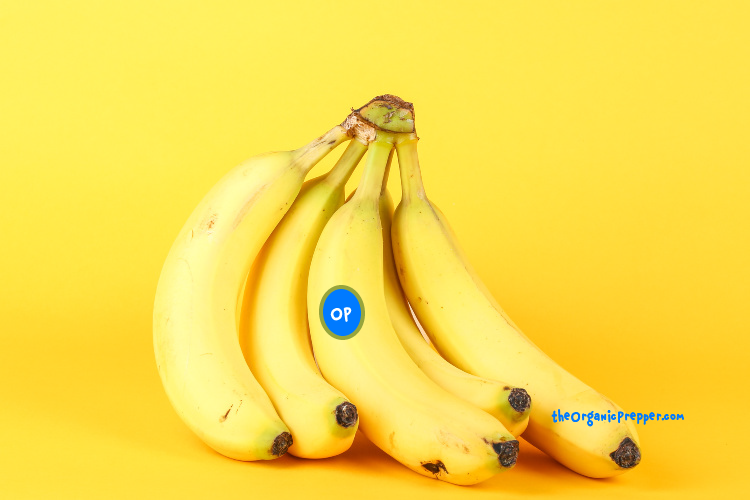If you're new here, you may want to subscribe to my RSS feed. Thanks for visiting!
Have you ever thought about how wildly unrealistic and unsustainable our current diets are? For example, items that don’t grow within the same season are commonly consumed together. Things that don’t grow on the same continent are combined into all sorts of meals. We eat blueberries in December and drink pumpkin spice lattes in the summer. We eat tropical fruit with Midwestern grains. Without the transportation system, there would be absolutely no rhyme or reason to our “normal” diets.
What is a typical breakfast in the United States?

Imagine if the grocery store supply lines shut down. If you had to eat what you could acquire without the national food transport network, how likely would it be that you could replicate that breakfast? It seems simple, but it’s not going to happen.Think for just a moment about how ridiculous such a combination would have seemed to our ancestors. Let’s forget for a moment that the breakfast mentioned is processed and loaded with GMOs. Let’s just think about the origins of the food. If you live where wheat is growing, it is not too likely that there will also be bananas and oranges growing. You’ve just invalidated the typical American breakfast in that sentence.

We picked the berries ourselves a short walk from our home on Friday. The duck eggs came from a nearby farm. It was filling, healthy, and delicious. You could easily add some local meat to the breakfast or a bowl of porridge made from whatever grain grows nearby (like corn, rice, oats, or quinoa, depending on your location). Nearly every agricultural zone has a grain that grows well if you wish to acquire or farm them.
Does your diet need to change?
It’s time to look at your diet very differently. I can almost guarantee that the transit supply line won’t be there indefinitely. And even if stores do remain open, how long will food be financially viable? Even if you can acquire food at your local market, the prices will continue to increase dramatically, and getting food from far-flung locales will be out of the price range for the average person.
Many signs point to an economic collapse and for many different reasons, rapidly rising food prices.
This article is not about building a good stockpile. While that ensures you won’t go hungry within a finite period, being able to feed yourself from the resources in your area is even more important than a fully loaded pantry. Many people are so enmeshed in the food transportation system that it would never occur to them to change their lifestyle to a less fuel-dependent one. By adjusting the way you eat to your environment now, you’ll be that much further ahead while the system disintegrates.
What would your diet be like if there was no food transit system?
So what would you eat if you had to get everything relatively locally?
An excellent place to start is your farmer’s market. (Find one in your area HERE) If it is a market that is genuinely for area farmers (i.e., not one that allows vendors to purchase things in the nearest city and present them as fresh and local), then it will give you a good idea of what is in season and what grows well in your area. The less expensive the food, the closer you are to the heart of the season for that particular fruit or vegetable.
Ways to learn about your area’s agriculture:
- Join a gardening group. Even if you are apartment-bound and don’t have the space for a garden of your own, joining a group of local gardeners or homestead-minded people can help you learn about the local growing scene. Facebook abounds with local groups. The bonus is that you can make some friends and learn some skills while researching the area.
- See what grows wild. Where I live, there are blackberries everywhere – so many that they are considered an invasive plant! We go blackberry picking several times throughout the summer to help ourselves to nature’s bounty. You can often find fruit and nut-bearing trees along a hiking trail. By learning what grows wild, you can make the best choices for creating your own orchard or garden. If it can grow without any help, the plant will absolutely thrive with a little nurturing.
- Most importantly, see what doesn’t grow in your area. No one grows wheat in the locality where I live. The soil here is simply not right for it. They don’t grow bananas because the climate is not right for it. But fresh corn grows like a weed, as do berries and nut trees. If no one farms it in your area, you will pay a premium price if you continue to eat the food while costs escalate.
- Check out your county extension office. There are some fantastic resources there for gardening, cooking, and preserving. All of the information you receive follows regulations from the USDA, but it is still a great (and free) educational resource. In fact, next month, I’m taking advantage of a class at my resource office to learn more about making jerky.
How to use locally grown food

This week, I bought a basket of garden overrun from the lady who supplies us with fresh milk. I got a tremendous amount of vegetables – more than we can possibly eat this week. I am going to preserve them for later use during the year when produce is not as abundant.
When you look at that photo entire meals and more should come to mind. For example:
- Pickles and salsa for canning
- “Zoodles” made with a spiralizer that can be dehydrated.
- Marina Sauce to served over eggplant with homemade Ricotta
- Heirloom cherry tomato salad with fresh basil from the garden
What about the winter when nothing is growing?
Many foods can be accessed year-round, such as meat, eggs, and dairy. However, in many areas, with the right set up, you can also grow throughout the year. There are lots of different agricultural zones, and this is where your county extension office can come in handy yet again.
We purchased one of those inexpensive greenhouses at the end of the season this year. We plan to erect that in our yard in the fall. This winter, we should be able to grow some hardy greens for salads and stir-fries. During the coldest, darkest days of winter, we grow tender lettuce and herbs in a sunny windowsill.
In some regions, hoop houses and cold frames can extend your growing season 1-2 months on either end of the regular growing season. As well, you have to plan ahead like our ancestors did. Winter has been coming every year for a long time now – it shouldn’t be a surprise to anyone that it’s happening again this year and that they need to prepare for it. Now is the time to pick and preserve so that you can feed yourself throughout the winter. I’ve canned jams, fruit, coleslaw, tomato juice, pickles, and salsa, and I’m just getting started. This is the busy time of year for those seeking an agrarian lifestyle because it’s time to start seedlings for a fall garden.
Learn more about canning HERE.
Learn more about dehydrating HERE.
Learn more about fermenting HERE.
Learn more about root cellaring HERE.
Seasonal eating is very healthy.
If fruit needs a passport to get to you, it can’t really be considered “fresh fruit.” When you demand produce that is out of season, it’s coming from across the globe. This means the items were picked before they were actually ripe, which means that the nutrients had not fully developed. The vitamins and minerals contained in produce begin to decrease the minute the food is picked. The harvest item immediately begins to die and decompose. By the time the food arrives at your local grocery store, it might already be 3 weeks old – and sometimes it’s even older.
What’s more, the packing plants take great pains to be sure that the fresh fruits that grace your table at Christmas look pretty. Many packagers add a waxy, glossy coating to produce before shipping. The coating not only looks shiny and inviting, but it also slows down the decomposition of the fruit or vegetable. Some foods are sprayed with preservative chemicals, as well, to help them survive the arduous journey to your supermarket.
Reducing the distance your food travels isn’t the only health reason to eat seasonally. Nature provides certain foods at certain times because that is when your body needs them the most. They are also less likely to be drenched in pesticides, fertilizers, and fungicides if the plants are growing as nature intended them to.
Tender leafy sprigs like lettuce, kale, peas, and pea shoots, and asparagus provide vitamins K and folate, which support blood health, bone health, and cell repair. These fresh, delicate foods are light, low in calories, and rejuvenating to the body as you gear up for the upcoming warm weather. Feasting on these waistline-friendly foods is a great way to get rid of that insulating layer of fat that you may have acquired during the winter.
In the summer, delicious berries actually provide protection against the intense rays of the sun. In-season foods like corn, peppers, and tomatoes are light on your stomach during the blazing hot weather. Many summer vegetables can be eaten raw and require no cooking, so you don’t have to heat up your house to prepare them.
In the fall, you should begin to look for foods that provide more warmth – carrots, sweet potatoes, apples, and pumpkins, to name a few. The beta-carotene in many of these autumn treats will boost the body’s germ-fighting cells to strengthen your immune system for the upcoming cold and flu season.
Finally, in the winter, you should consider eating more carbohydrates like those from root vegetables – they help the body sustain a little more weight, which is needed to insulate against the cold weather. Warming vegetables like potatoes, cabbages, carrots, onions, rutabagas, and winter squash all store well in cool, dark places, providing energy and comfort throughout the winter. Adding more fish to your diet during this time of year is also beneficial for the warming effect, the higher calories, and the high levels of vitamin D (the vitamin you get directly from the sun during the warmer months). Vitamin D is essential for good mental health and a robust immune system. Nuts, which store well for the winter, are loaded with Omega 3 fatty acids, which help moisturize your body from the inside out and heals the dry winter skin so many of us suffer from.
Seasonal eating is excellent for your budget!
By growing what you can and acquiring things when they are most abundant, you’ll save a lot of money. As I discussed above, several current economic issues are going to cause the costs of our “average American diets” to skyrocket. Reliance on long-distance food at the grocery store will simply be financially unsustainable.
When gas prices continue to climb, that cost will be pushed off on the end consumer: the person buying that food from the store. The further the item has to come to get from you, the more fuel it takes to get it. Soon, those December blueberries will be out of reach for all but the wealthiest of families. Why not pick your blueberries in the summer and can or freeze them if you want to have blueberries in December?
You must also take into consideration extreme weather over. Droughts in California have meant that many farmers had to let formerly productive fields lie fallow to concentrate their limited water supply on the remaining fields. This causes a shortage of particular foods, which will make them more expensive, based on the laws of supply and demand.
However, this doesn’t have to affect you as severely as it will those who rely solely on the grocery store to get their food.
Things are still growing, and they are probably growing near you. I cheerfully take those huge zucchini clubs that my neighbors don’t know what to do with and preserve them for the winter ahead. There is still a lot of abundance in our country, the thing is that abundance near you is happening RIGHT NOW, not in 6 months. You have to think ahead by getting things while they are at their peak – at this point in time, people with gardens have a tremendous amount of overflow. The key to making this help your budget is saving that overflow for later when it will be outrageously expensive to get it from the store.
You don’t have to be an expert to grow food.
Well, I sure hope not. Otherwise, we’ll starve. I have grown gardens before. Some have been so successful that they looked like a lush jungle in my yard, while others have wilted, laying down in defeat in the blazing sun. I’m definitely not a master gardener. I wouldn’t even say I have a green thumb. (Just summon a medium and ask some of my victims – I am like the serial killer of once-thriving house plants). I’m telling you this so you know that anyone can do it if they desire to do so: no genetically inherited alien-colored digit is required.
You don’t have to be an expert, but you do have to be determined. You have to be willing to ask others in your area who have been growing for years. You have to observe the things growing in your region. You have to be ready to put in hard work and get dirty. And if something dies, you have to cut your losses and try something else. I recently thought I had killed my herb garden during the last heatwave. I uprooted everything – it was all wilted and semi-dead looking, and re-potted in containers, which I moved to a shadier location. I lost some plants, but more than half of them surprised me by bouncing back. From this I learned two things: 1) Where NOT to plant herbs next year and 2) If it’s already dying, what can it hurt to try something new? It might finish the plant off, or it might give it a chance to rejuvenate.
Most of all, realize that if you keep plugging away at it, you can grow food. If other people in your area are growing food, it can be done. If it can be done, you can do it too. For centuries, this was how people got enough food to eat, and the human race hasn’t died out yet. This means that, given a little bit of space, you can grow food too.
Chime in!
What’s growing in your area right now? How are you preserving it? Do you have suggestions for those who are in a situation where they can’t grow a garden?

















I love your articles! Thanks for all the advice! I am one of those people you mentioned in the article-that person with the extra giant clubs of zucchini. Just what do you do with them? Right now we amuse ourselves with watching the dogs play them. But if times get tough in the future I was wondering what else I could do with them.
Grate them up, put on a cookie sheet in the freezer, when frozen, bag them up and then throw them into stews, soups, etc. over the winter. They are also great in cookies and bread
Thanks!
I grate mine too, but I put them into freezer bags right away. 2 cups is what is usually required for most cake, cookie and muffin recipes.
Learn to eat your yard. Almost everything there grows year round. That is especially true of chickweed, dock and dandelion… the Round Up targets and victims. Eat them, don;t kill them with herbicides. Now,THAT’s cheap eating.
Daisy,
Great article, I started a small garden 4 years ago after turning off the TV. I now have a large garden, an indoor grow room and a hydroponics set up under the carport. I also have a tea garden in the front yard.
I don’t buy produce the the grocery store and I give away a lot of my vegetables that I can’t eat.I also trade them for fresh eggs and other stuff. I only jar the tea so far as I need to learn how to preserve the other veggies.( need to be prodded)
I can honestly say that growing your own food is the most liberating experience you’ll ever have in your life:)
Fantastic article, I am currently growing Cassava trees, Okinawa spinach, Bulgar spinach, Chaya (Mexican Tree Spinach), chufa (Nut Grass I think),Cuban oregano, oregano, Blue french basil, bee balm, thyme, rosemary, mulberry, pear, loquat, plum, chestnut, canna lilly, chinese water chestnuts, Pineapple, apple, several others.
I grow these on not much land, it isn’t hard if you use your head. I grow Thyme, mint, rosemary, cuban oregano, and oregano in the bottom half to a weber grill my neighbor was sending to the landfill.
I have never been much of a gardener, but in the last year i have created a pretty substantial edible landscape. Grow and have fun with it, some day you may be very glad you did.
Great article. Everyone needs to be thinking about what Grandma had in her larder, cold cellar, and garden-because that is they way we are going to be living in the future. Depending on where Grandma lived, she had different foods at different times. In Ohio, breakfast was cream of wheat, oatmeal, or eggs and sliced ham in the winter. When we came to California, fresh fruit became a normal in the winter. Eat where you live, I guess. My Grandma never went to the grocery first: she “shopped” her pantry, cold cellar, or garden. Then-and only then-did she say to my mother, “We need to visit the grocery”. I can’t remember anyone who didn’t love an invitation to a meal, no one starved, and her table was always groaning. Society does everything backwards now. We need to get back to the future!
Thank you Daisy. Also, get a rifle, and learn to hunt, the deer population is at an all time high, so are wolves, bear, and lion, so be aware when out there, the predators are back, after my forefathers limited their numbers, so your kids don’t get eaten. also, great self defense, for us all. As we all know, even the trolls who come on here and try to debunk, our nation is in danger, but know this, we aint beat, and NO country on earth stands a chance against our armed population. I’m thankful for that. Im thankful, that i have a natural born right to bear arms, and to hunt for my food. I hate war, but I hate seeing our people killed, or starving, because they are not ready to survive, because they believe all is well, all is not well, last time, be silent, be aware, all is not what it seems. watch what these politicians DO, not what they say.
We love ya daisy.
Also, if you have lakes around you, go fishing for your food. You can eat is fresh, freeze it, or pickle northerns.
It’s not for everyone, but raising and butchering your own pastured animals is a real money saver,
Thankfully, I live in a time when food can be grown worldwide and transported to me and sold 365 days a year cheaper than I can grow it myself. As long as that food is not subsidized by my fellow Americans via the fleecing of their earnings I have applaud that. As long as competing sources of food are not regulated out of my mouth I can applaud that.
And while I might like to take the time to refute the idiots who would oppose buying food I do have to concede that were it to stop overnight I and the vast majority of America would starve, that the quality of the food is nowhere near as high as that I could grow for myself were I willing to spend a good deal of my life and treasure laboring to grow such food daily and surviving the daily assaults upon my crops and livestock by the weather, pests, weeds, diseases and nutrient deficiencies.
Zucchini makes the moistest chocolate cakes. Lots of recipes out there. Mine calls for 2 c. so I just grate & put 2 cups per bag & freeze. This year my seeds didn’t grow but I’m sure someone will have extra.
With all the rain this spring we lost most of our broccoli but the rain was a blessing to the asparagus so I have frozen enough for 1 pk. per week for the year plus canned 16 pt soup. Most years bring an abundance of some things and lack in other areas. The past 2 years we had an abundance of tomatoes but we had the blight for 2 years before that. I try to have extra tomatoes canned in case we get blight again. Since our area had never had blight before we were not prepared. Each year brings surprises and we try to learn from them but gardening is a life long learning experience.
Right now the raspberries & peas are just starting. We have had a few meals but nothing for the freezer yet. Love them fresh though. The cucs are starting..eating but not pickling yet.
As for abandoning the store, we won’t need to buy veg. or fruit, & we still have have some local meat,& local wheat & we just bought about 70 lb. of rolled oats that are milled 70 miles from here. We just have to buy fresh milk, cheese & eggs. We always have powdered & canned milk on hand. Our neighbour will supply us eggs in 10 more weeks when her chickens start laying. The other things we will buy @ the store is at the Aug case lot sale. I don’t know what will be on sale. Some years its healthy food other years it is mostly junk food or things we produce. Time will tell. Middle of Aug. we will pick sour cherries at a U-pick to can, make juice & jam so may need to buy sugar at store. We have our own maple syrup that we put on our porrage, pancakes etc & we will buy honey from a local beekeeper.
We are definitely not totally self sufficient but try to do what we can. Thank- for this great article.
This article is spot on! Fantastic job! I have been screaming this forever … you can not eat so many things at the same time … it is just impossible to do and unrealistic if you ever had to provide for yourself.
Besides gardening, something that I am passionate about, one of the best things someone can do to just move in the right direction, is to eat only what is in season for their area, and of course preserve what’s in season so you can eat it when it is not in season.
Inspired by this web site, but HELP, I am totally a newbie. I could use some beginner reading materials to become a little more independent of the conglomerates! Anyone have some suggestions?
The Vegetable Gardener’s Bible: Edward C. Smith …
This is a great book and a wonderful way to start gardening. I would also recommend the documentary Back to Eden. Good Luck
Flippin hilarious. Thanks for the laugh. Progress?